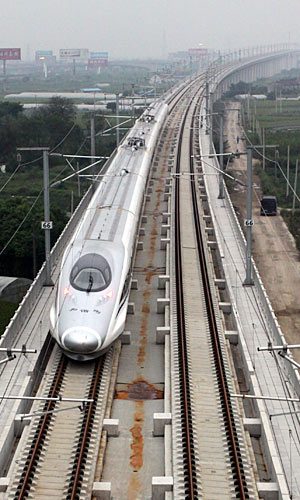|
 |
|
THE FASTEST TRAIN: The Shanghai-Hangzhou High-Speed Railway is on a trial operation. The train can run at a record speed of more than 410 km per hour (HU LINGXIANG) |
Economic Forecast
China's GDP growth is projected to average 10.5 percent in 2010 and 9.6 percent in 2011, mainly driven by domestic demand, according to the IMF's biannual World Economic Outlook (WEO) report released on October 6.
"The slight moderation in recent activity is expected to continue through 2011 in light of tighter quantitative limits on credit growth, measures to cool off the property market and limit bank exposure to this, and the planned unwinding of fiscal stimulus in 2011," the WEO stated.
The WEO also said this year's sustained growth in retail sales and industrial production confirms that private sector activity has advanced beyond the initial boost from the government's stimulus.
"On average, from 2010-11, private domestic demand is poised to contribute two thirds of near term growth, and government activity about one third, whereas the contribution from net exports will be closer to zero," said the WEO.
Limiting House Purchases
The Shanghai Municipal Government issued a new regulation on October 7, limiting families to the purchase of one new apartment. It's part of nationwide efforts to curb property speculation and soaring house prices.
Every household in Shanghai is permitted to purchase only one more commercial residential property as of October 7 and anyone found in violation of the regulation will not be allowed to register their ownership of the property.
According to the regulation, property developers are required to pay a value-added tax (VAT) on land, which ranges from 2-5 percent. The higher the property is priced, the more VAT property developers have to pay.
The regulation also states that the city will take the lead in initiating a property tax in preparation for the official property tax to be launched.
Iron Ore Demand
Domestic iron ore output will reach 1.1 billion tons, and iron ore imports this year will not exceed last year's 628 million tons, the China Iron and Steel Association (CISA) estimated.
China will recycle more steel scrap—an expected 100 million tons—to reduce iron ore imports, said Shan Shanghua, Secretary General of CISA.
Meanwhile, for months, production by steelmakers was reduced due to weak demand from the real estate and automotive industries. The country also cut power supplies to some steelmakers to fulfill energy saving targets.
Anti-dumping Duties
China began levying anti-dumping duties of 50.3-105.4 percent on imports of U.S. chicken products as of September 27. The anti-dumping measures will be applied to U.S. broiler products for five years, the Ministry of Commerce (MOFCOM) said.
The U.S. chicken industry has dumped broiler products into the Chinese market and caused substantial damage to the domestic industry, MOFCOM said, citing the results of an investigation initiated one year ago.
The ruling holds that there is a causal relationship between the U.S. dumping of broiler products and the losses suffered by domestic businesses.
The MOFCOM's action came after China imposed anti-subsidy duties ranging from 4-30.3 percent on U.S. chicken products in late August for five years, after it concluded U.S. producers had received improper government subsidies and were hurting the domestic industry. | 